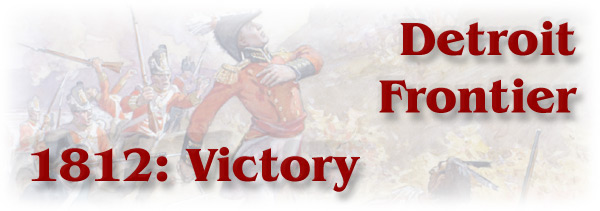
Table of Contents
Home | Setting the Stage | Battlegrounds | Militia and Civilian Life
Prisoners of War | Loyalty and Treason | The War Ends
After the War | Chronology | Soldiering in Canada
Important Figures | Important Places| Glossary
Sources | Links | The Making of a Virtual Exhibit
![Portrait: Major-General Sir Isaac Brock, K.B., [ca. 1883] Portrait: Major-General Sir Isaac Brock, K.B., [ca. 1883]](pics/694158_brock_270.jpg) |
His victory at Detroit and the bold front he presented, despite
limited resources, was instrumental in preventing an early victory
by the United States. Click to see
a larger image (77K) |
|
An artist's reconstruction of the meeting between Brock and Tecumseh in August 1812 which cemented the alliance between Great Britain and the First Nations in the Michigan Territory and further west. The subsequent capture of Detroit and Hull’s Army of the Northwest diverted American resources away from the St. Lawrence supply line toward the recovery of territory in the west. The peace treaty signed at Ghent
in 1814 failed to take the concerns of the First Nations into
account and in fact brought an end to the alliance between the
British Crown and the First Nations in the United States. Click
to see a larger image (112K) |
![Drawing: The meeting of Broack and Tecumseh, [ca. 1921] Drawing: The meeting of Broack and Tecumseh, [ca. 1921]](pics/621231_brock_tec_270.jpg) |
|
| [ Return to top
of page ] |
||
|
||
It would have been included amongst the official documents seized as part of the surrender agreement. This is one of the handful of original images from the time of the war to survive. We are largely dependent on the written word and the works of historical imagination, like that of C. W. Jefferys, to depict how things might have looked and felt. |
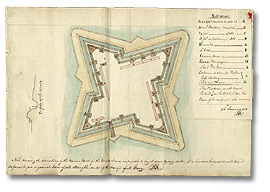 Click to
see a larger image (200K) | |
|
||
The fort and town at Detroit was the largest settlement in the northwest. Its possession was vital to both sides in the conflict.
Click
to see a larger image (282K)
|
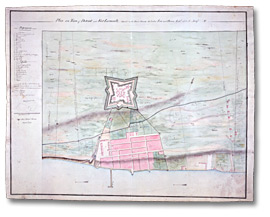 | |
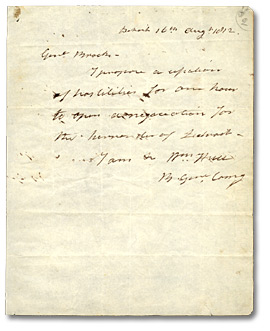 Click to
see a larger image (208K) |
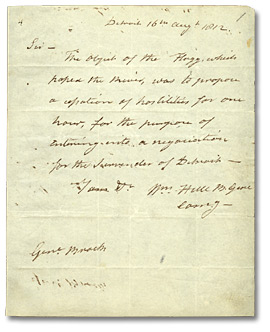 Click to
see a larger image (212K) | |
The first note reads: "General Brock, I propose a cessation of hostilities for one hour to open negotiations for the surrender of Detroit." The second reads "Sir, the object of the Flagg, which crossed the River, was to propose a cessation of hostilities for one hour for the purpose of entering into a negotiation for the surrender of Detroit." The unexpected decision to give up a strong, well-garrisoned position without a fight likely fuelled confusion on the British side. Any confusion was quickly settled and terms for the surrender of the Fort and its garrison were concluded. General Hull was court martialed for cowardice by the United States Army for the surrender and convicted, but escaped execution based on his record in the American War of Independence. |
||
| [ Return to top
of page ] |
||
|
||
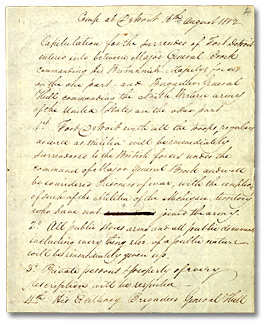 Click to see a larger image (300K) |
Transcript Camp at Detroit 16th August 1812 Capitulation for the surrender of Fort Detroit entered into between Major General Brock commanding His Britannick Majesty's forces on the one part and Brigadier General Hull commanding the North Western Army of the United States as the other part. 1st Fort Detroit with all the troops, regular and militia, will be immediately surrendered to the British forces under the command of Major General Brock and will be considered prisoners of war, with the exception of such of the Militia of the Michigan Territory who have not joined the army. 2nd All public stores, arms and all public documents including everything of a public nature will be immediately given up. 3rd Private persons & property of every description will be respected. 4th His Excellency Brigadier General Hull having expressed a desire that a detachment from the State of Ohio on its way to join his army as well as one sent from Fort Detroit under the command of Colonel McArthur should be included in the above capitulation - it is accordingly agreed to - It is however to be understood that such part of the Ohio Militia as have not joined the army will be permitted to return to their homes on condition that they will not serve during the war - their arms however will be delivered up if belonging to the public. 5th The Garrison will march out at the hour of twelve o'clock this day and the British forces will take immediate possession of the Fort. (Signed) W. Hull, Brigadier General
True Copy |
|
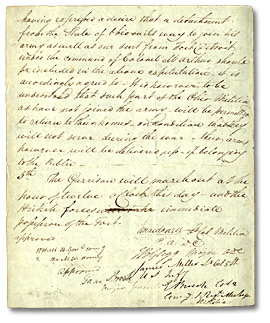 Click to see
a larger image (294K) | ||
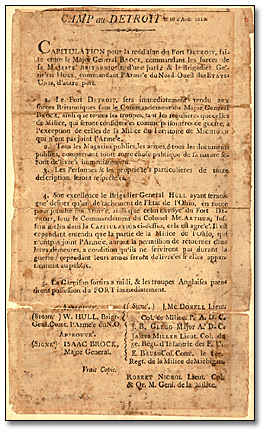 |
Posters displaying the terms of General Hull's surrender at
Detroit were posted in the Ohio Territory and Upper Canada in
French and English. Click to see a
larger image (439K) |
|
| [ Return to top
of page ] |
||

 ajor-General
Sir Isaac Brock served as the commander of British forces
in Upper Canada from the beginning of the war until his death
at Queenston Heights in October 1812.
ajor-General
Sir Isaac Brock served as the commander of British forces
in Upper Canada from the beginning of the war until his death
at Queenston Heights in October 1812. 
 his
watercolour plan was likely prepared by a engineering officer
of the United States Army. The dates indicate that it was created
a few months before the declaration of war; the note attached
to the plan includes information on the state of the defences
and armament of the fort so it was likely drawn as part of a program
to indicate the condition of fortifications along the frontier
in anticipation of a declaration of war.
his
watercolour plan was likely prepared by a engineering officer
of the United States Army. The dates indicate that it was created
a few months before the declaration of war; the note attached
to the plan includes information on the state of the defences
and armament of the fort so it was likely drawn as part of a program
to indicate the condition of fortifications along the frontier
in anticipation of a declaration of war.